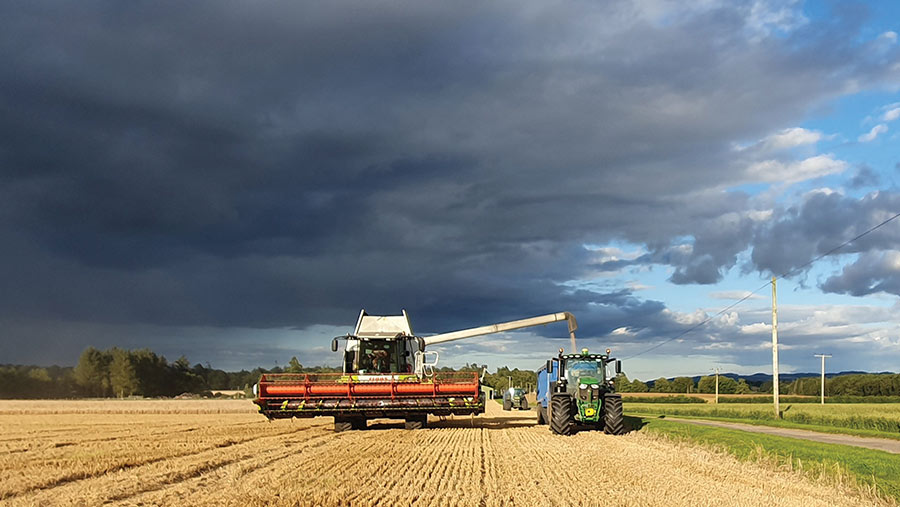Harvest 2023: 80% of rapeseed still to cut in the North
 Racing to get winter barley cut in Angus © Peter Ray via Farmlife Framed gallery
Racing to get winter barley cut in Angus © Peter Ray via Farmlife Framed gallery Forecasts are looking more positive for farmers to get into their winter wheat across the country, with those in the North still to finish oilseed rape.
So far it has been showing lower oil content than last year, although Aurelia stands out as a highlight.
See also: Why blackgrass is so bad in 2023 and what to do about it
Tyne and Wear
In the North-East not a lot of wheat has been cut, winter barley harvest is 75% complete and oilseed rape is 20% through, says Gary Bright, managing director at GrainCo near South Shields.
“A bit of wheat was sprayed off prior to the rain so there will be some wheat done this week,” he says.
The store is still awaiting spring barley, but winter barley quality and yield have been down on last year, at 62-63kg/hl specific weight and 6.2-8t/ha.
Most has been coming in at 16-17% moisture, with Tardis standing out as the best variety so far.
“Rapeseed was coming in dry off the field yesterday [7 August] at 8% moisture content,” says Gary.
“But we’ve also had rapeseed come in at 28% moisture: the full spectrum.” The standout oilseed rape variety this year is Aurelia.
North Yorkshire
High Farm near Brandsby received 202mm rain in July, so concerns over soil structure damage have dominated decisions on whether to travel in fields or wait another day.
Keith Snowball has combined 120ha of his own and a contracting farm’s winter barley, made up of both six-row varieties and the two-row Tardis.
It came off at an average moisture content of 16%, yielding 7.5-9t/ha at 63-68kg/hl specific weight.
Keith has also cut 14ha of his own Aurelia oilseed rape. “We cut it at between 12% and 15% moisture because it was starting to sprout in the pods,” he says.
He estimates it yielded 4.6t/ha and 42-44% oil content.
Next is 800ha of Crusoe and Extase milling wheat, for which Keith has quality concerns.
“We’re on top of a hill so our land will travel, but we were making deep impressions from combine wheels yesterday [6 August].”
Cambridgeshire
Camgrain has received 40,000t of spring malting barley averaging 16.5% moisture and 50,000t of winter malting barley averaging 15.5%.
Although malting quality is generally good, winter barley retentions are below average, dropping as low as 60%.
“Small grains within barley samples are higher than normal, so it will need additional cleaning, which results in weight loss,” says operations director Philip Darke.
Spring barley nitrogen levels are also below average.
Camgrain has also received 3,000t of winter oats and 8,000t of spring oats, with an average moisture content of 16% and 53kg/hl specific weight.
Farmers are pleased with the cereal yields, and the store has taken in 12,000t of Group 1 wheat at an average of 18% moisture, Hagberg above 300, 78kg/hl specific weight, and 12.5% protein.
“We are encouraging members to push on and capture quality, and make use of our substantial drying capacity in this challenging stop-start harvest,” says Philip.
Oilseed rape yields have been disappointing, but the 20,000t in store has come in at an average moisture content of 9.5%, with oil content above 44%.
Wiltshire
To the south-west, United Oilseeds near Devizes has 50 third-party grain stores filling up quickly, albeit with the weather slowing the pace compared with last year.
Trading manager Owen Cligg reckons 80% of the crop has been cut in the South, about 50% in the Midlands, 40% in the North and 5% in Scotland. The two main varieties are Aurelia and Attica.
“Yields are disappointing at the moment; 10-20% down from last year, averaging 3t/ha,” says Owen.
Oil contents are generally lower than last year, and admixture is higher.
“We are seeing oilseed rape over 10% moisture content that needs to be dried,” he says.

